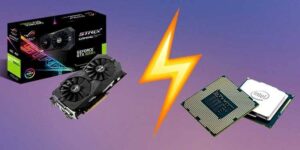Introduction
A Graphics card is known as GPU (Graphics Processing Unit), the graphics cards works by processing and executing complex mathematical calculations related to rendering graphics. It has its own dedicated memory (VRAM-Video Random Access Memory) to store and quickly access graphical data. All games needs a graphics card memory to start, and it depends on the type of the games.
Types of Graphics card
Graphics cards comes in various types, and they can be broadly categorized based on their intended use, performance levels, and form factors.
- Integrated graphics :
- Many CPUs come with integrated graphics, which means that the graphics processing functionality is built into the same chip as the central processing unit (CPU). Integrated graphics are typically less powerful than dedicated graphics cards but are sufficient for basic tasks like web browsing and office application.

- Discrete graphics :
- Discrete graphics cards are standalone cards dedicated to graphics processing. These are more powerful than integrated graphics and suitable for demanding tasks such as gaming, video editing, and 3D rendering.
- Two major manufacturers of graphics cards are AMD and NVIDIA. They produce a wide range catering to different market segments. Each company has its own series and models, such as NVIDIA’s GeForces and AMD’s Radon and Radon pro.
Components of Graphics Cards:
- GPU (Graphics Processing Unit):
- The GPU is the primary component of a graphics card responsible for executing complex mathematical calculations required for rendering images and graphics. It contains thousands of processing cores optimized for parallel computing tasks.
- VRAM (Video Random Access Memory):
- VRAM is dedicated memory integrated into the graphics card used to store and access graphical data quickly. It enables the GPU to store textures, shades, and frame buffers, improving rendering performance and overall graphics quality.
- Cooling System:
- Graphics cards feature cooling systems, including fans, heat sinks, and sometimes liquid cooling solutions, to dissipate heat generated during operation and maintain optimal temperatures for efficient performance.
- PCB (Printed Circuit Board):
- The PCB provides the physical foundation for mounting components and connecting circuits within the graphics card. It includes interfaces for power supply, video output ports, and connectivity with the motherboard.
- Power Connectors:
- Graphics cards require external power from the computer’s power supply unit (PSU) to operate. They feature power connectors, such as PCIe power connectors or 6-pin/8-pin connectors, to deliver sufficient power to the GPU.
- Video Output Ports:
- Graphics cards offer various video output ports, such as HDMI, Display Port, DVI, and VGA, to connect to monitors, displays, and other external devices.
Graphics Card Manufacturers:
- NVIDIA:
- NVIDIA is a leading manufacturer of graphics processing units (GPUs) known for its GeForce GTX and GeForce RTX series of graphics cards, catering to gaming, content creation, and professional applications.
- AMD (Advanced Micro Devices):
- AMD manufactures Radeon series graphics cards, offering competitive alternatives to NVIDIA’s products for gaming, content creation, and workstation applications.
Applications of Graphics Cards:
- Gaming:
- Graphics cards are essential for gaming PCs, rendering immersive and high-quality graphics, enabling smooth gameplay, and supporting features such as ray tracing and virtual reality (VR).
- Content Creation:
- Graphics cards accelerate rendering and processing tasks in content creation applications such as video editing, 3D modeling, animation, and graphic design.
- Machine Learning and AI:
- Graphics cards are utilized in machine learning and artificial intelligence applications for parallel computing tasks, training neural networks, and accelerating data processing.
- Scientific Computing:
- Graphics cards are employed in scientific research and simulations for complex calculations, data visualization, and computational modeling.
Different sizes and profiles of graphics cards:
- Low Profile Graphics Cards:
- Low profile graphics cards are designed to fit into smaller-sized desktop computers where space is limited.
- These cards have a reduced height profile, typically less than the height of a standard PCIe slot.
- Some low profile cards are even referred to as “half-height” cards, meaning they are significantly shorter than standard cards.
- Variation in Size:
- Graphics cards can vary in length and thickness, with high-end models often occupying two or three expansion slots.
- Modern high-end graphics cards, such as the RTX 4090, can exceed 300mm (about 11.8 inches) in length.
- The thickness of a graphics card can also vary, especially with models featuring advanced cooling solutions or custom designs.
- Considerations for Compatibility:
- Choosing a lower profile graphics card is beneficial when trying to fit multiple cards into a system or when facing clearance issues with other motherboard components, such as DIMM slots or PCIe slots.
- Larger computer cases, such as mid-tower or full tower cases, provide more space and flexibility for accommodating larger graphics cards.
- Full tower cases, in particular, are capable of housing large motherboards, such as ATX or micro ATX, along with multiple expansion cards.
- Case Compatibility:
- When selecting a graphics card, it’s essential to consider the compatibility with your computer case.
- Smaller form factor cases may have limitations on the size of graphics cards they can accommodate, while larger cases offer more versatility.
Conclusion
In conclusion, graphics cards stand as indispensable components within desktop computers, enabling the rendering of images, videos, and graphically-intensive tasks. This guide has shed light on various aspects of graphics cards, emphasizing their diverse sizes, profiles, and compatibility considerations.
The significance of size and profile is crucial, as it ensures proper fit within computer cases and motherboards. Additionally, considerations regarding length and thickness underscore the importance of selecting a card that aligns with system specifications to avoid interference with other components.

